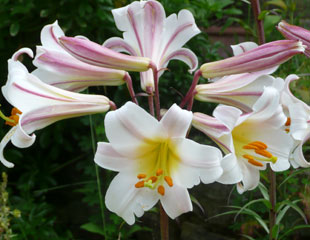
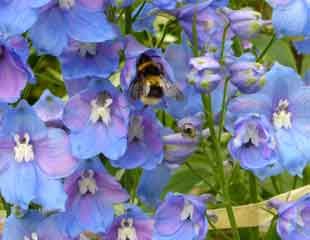
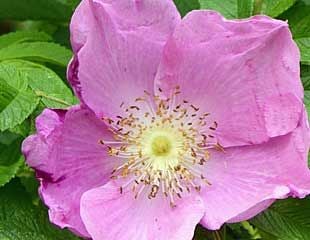
What to do in the garden in July
The garden is in full swing with many gardens at their peak in July, along with the veg plot full of produce. It's a lovely time of year in the garden.
At their best in July are Delphiniums, Agapanthus, lavender, various Clematis, Achillea, Dahlias Nepeta Thalictrum late flowering Peonies, Day Lily, Roses, Sweet peas, Honeysuckle; it's all blooming, and the garden is full of beautiful scents.
Check out Shrubs and Plants flowering in July for planting inspiration.
One of the main gardening tasks in July is dead heading the various flowering plants. For most plants, this just means snipping off the spent flowers, but for some plants it's a little different. Also, it is important not to dead head any plant which you want to display berries or hips later in the year, such as Rosa rugosa or Honeysuckle.
Keep on dead-heading
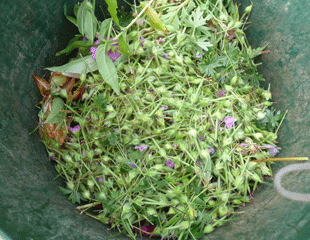
If you have little for any gardening task, if you can spare a few minutes, it is worthwhile deadheading. To keep summer plants and bedding at its best and to prolong flowering, it is essential to spent flowers. This is because once the plant has flowered and set seed, so it can reproduce, plants are often reluctant to flower again.
Cutting off the spent flower head encourages the plant back into the cycle to produce flowers and seeds again. Some plants, illustrated is Mesembryanthemum. Common name Ice Plant, need a lot of attention and constant dead heading.
It is worthwhile dead heading summer flowering Clematis to produce more flowers as the season goes on.
Some plants require so much dead heading that it can be easier to use shears to cut off the top growth. This often results in new green growth and sometimes a second flush of flowers and is useful for Alchemilla mollis, commonly known as Lady's Mantle, hardy geraniums (not Pelargoniums), chives, and Nepeta.
How to dead head roses
There is a specific way to dead head Roses. It is best to snap off, not prune away, the spent flower and it will break just below the flower bud. An equally well-respected way to dead head roses is to prune back from the dead flower to the next leaf joint. Peter Beale is a well known rose grower and his video advice on dead heading roses is very useful.
How to dead head Delphinium, foxgloves and Verbascum
When the flower spike has faded and gone over, cut it back by removing the flower head only, as in just the flower spike, not the whole stem and where there are side shoots surround the flower head, these may produce a second flush.
Cut back early perennials
Early flowering perennials can look a bit tired by July and their foliage is becoming tatty and brown. If these plants are cut back now, many will produce fresh green growth to liven up the border and sometimes even a second flush of flowers. Good candidates for this treatment are Oriental poppies, Alchemilla mollis, hardy Geraniums, Nepeta. Cut back close to the ground, feed and wait a couple of weeks. It can look a bit bare when you first to this and if you don't like the sight of too much earth, cut back just before you go on holiday. It seems a bit drastic to razor over Alchemilla mollis, but in a couple of weeks time you will be rewarded with a fresh green mound of new leaves.
What are rose suckers
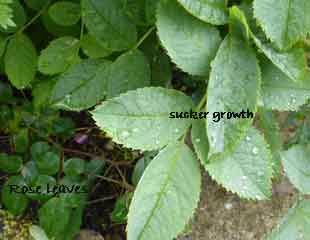
Suckers can be a problem with Roses because Rose cultivation involves grafting. A sucker is an unwanted growth from the rootstock and it is often vigorous growth and can over-take the Rose. The image left is Rosa "Little Pet" which shows the true rose foliage, darker and more compact foliage, at the bottom right of the image. At the top and left in the image shows is the sucker foliage, which is lighter. The leaves are similar but a different shape and it is more vigorous. If you have a rose bush which is showing one or two shoots which are growing much more strongly, examine it to check, it is not a sucker.
Suckers really do sucker the life out of the rose and need to be removed. Using thick gloves, go to the base of the plant where the sucker is exiting the soil, scrape away the soil and if the sucker is quite new, it should be possible to pull it away below the rose graft at the base. In this case,the sucker was well established, and it was not possible to pull it away without causing damage to the plant, so you will need to prune it instead.
Summer Prune Wisteria
July or early August is the time to prune Wisteria for the second time in the year. Twice yearly pruning is essential to keep Wisteria flowering each year. If you grow Wisteria, prune now, otherwise you may jeopardise next year's flowers. Pruning Wisteria in July/August and Jan/February is essential to maintain flowering, but it can be time-consuming because of the plant's potential for significant growth and the need for ladders to reach the upper parts of the plant.
Prune back the whippy summer growth to contain the plant. Wisteria is vigorous and needs harsh treatment. Cut the whippy tendrils which have grown over summer back to about 15cm (6") long. There is a popular Sunday Gardener video viewed over 200,000 times on how to grow and prune Wisteria. If the main stems are growing out of their allotted space, cut back now to restrict the plant. This is a good time to feed Wisteria and tomato feed is suitable if your plant looks in need. I have never fed wisteria, and if it is growing well, do not to feed. You risk upsetting the balance between green leafy growth and flowers, and getting even more leaf growth.
Visit the Wisteria page where information about pruning Wisteria and how to ensure it flowers year on year.
Tips on growing Sweet peas
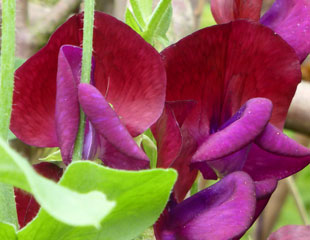
Sweet peas are lovely, but at this time of year to keep them at their best, sweet peas need regular attention.
To maintain flowering, it is essential to pick, pick and pick the flowers. Don't worry that by doing this, you will remove all the flowers. Picking all the flowers makes the plant produce more and more flowers. If any flowers have gone over and left a seed head behind, remove it. By doing this, you will keep the plant flowering. In a good summer, I have picked Sweet Peas until October.
Sweet Peas look best in vases when they have straight stems and to get those lovely straight stems you need to remove the thin tendrils which the plant produces. If you leave the tendrils on the plant, they will twine around other parts of the sweet pea plant, impeding its growth and pulling parts of the plant down, causing it to become tangled. The tendrils act as anchors holding the plant down. The plant becomes a tangled mess, and this prevents the flowers from having those lovely straight stems which look so lovely when displayed as cut flowers.
Take Clematis cuttings
If you want to try your hand at propagating Clematis, July is a good time. Cut off a length of recent growth, and then snip it into bits each about 8-10cms with a pair of leaves. It is important to have the node (knobbly bit on the cutting ) in the middle of the stem that you are going to use. Discard the very top of the cutting, which will be too soft. Fill a pot with seed compost, make a few holes and tuck cutting in with hormone rooting powder if you have it, but not essential. The trick, and why it works sometimes and not others, is the cutting must not dry out, but not too wet or it will damp/rot off. Try placing in propagator or put a poly bag over the pot and seal tightly with elastic band or string and place the warm but out of sunlight. Check weekly for signs of growth. To ensure it's not dried out water gently.
July in the Veg plot
By July, beans, lettuce, rocket, courgette, spring onions, strawberries and many early crops are ready for harvesting. At last its time to start eating and tasting. It is also the holiday season, if you are going away, check out holiday tips for ideas on how to look after your plants whilst away.
When to Harvest Potatoes
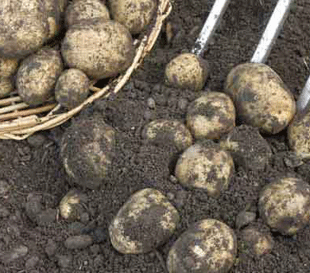
Potatoes, depending on the summer weather, usually need watering during dry spells, especially if you are growing potatoes in containers. Water is key to a good crop and potatoes in tubs easily dry out.
In addition, if you have time, it helps to get a good crop to "earth up" the potatoes as it allows more potatoes to form as the season goes on. To do this, as the potato grows and more stem appears above ground, you should add more soil to the container or mound up the soil in the plot, covering more of the stalk. For more about growing potatoes, follow the link and check out the video about earthing up and blight.
Depending on the weather, salad potatoes and Earlies will be ready to harvest in July.
How to tell when potatoes are ready to harvest?
First, have they flowered? Potatoes are not ready to harvest until after flowering and then check if they are ready by gently scraping away the earth and see what you find; if the Potatoes are too small or too few, cover up and try again in a couple of weeks.
But what if your potatoes do not flower? It is possible, usually in poor summers which are lacking in sun, and/or in gardens which are further north, that potatoes just do not flower. Usually, if you plant them in Mid March/April, they will be ready to harvest in about 10 weeks, which is mid to end of June. If they have not flowered by later in July, the only way to tel if they are reading is to scape and put your hand in and see what size of potatoes you can feel and decide from that if they are ready or not.
Growing Parsley from Seed
Although parsley can be tricky to germinate, it is worth trying in July. Sow in a line in the veg plot, ( sowing in lines helps to identify what is germinating seed, and what is germinating weeds. Weeds don't grow in straight lines.) Give Parsley some time as it's slow to germinate. Parsley will survive low temperatures later in the season and is an ideal herb for potting up and bringing indoors later in the year.
Peas and Beans

Keep picking Peas and beans whilst they are young, and if you have a glut, freeze. All the bean family freeze easily. Blanch them in boiling water for 2 mins, plunge into iced bowl to cool, pat dry and freeze. Keep picking all the peas and beans to encourage the plant to keep flowering and setting more seed.
Broad beans are very prone to black fly and, to prevent this, keep pinching out the tips to stop the black fly setting on the new growth, which is the bit they really like. This also stops off the plant growth so the plant's energies go to flower and bean production, not more growth.
When you pick the whole stem of beans clean of beans, cutting it down near the base can often encourage more growth and a second crop.
Late cropping strawberries

Botrytis, also known as grey mould, does attack strawberries. The affected fruit is inedible. Botrytis picks up the pace as the summer moves on and is more common if there are warm humid conditions.
There's no cure for Botrytis. The best prevention is good air circulation which is why Julyis a good time to remove some of the strawberry's leaves to improve air circulation. You may also find at the base of the plant some brown, dishevelled leaves which are best removed as well. Growing Strawberry tips
How to Make new Strawberry plants
In July you can raise new strawberry from the runners. Just place a pot of compost near the plant, peg the runner into the pot, water well and leave for a few weeks until well rooted. Cut off excess runners to conserve the plant's energies. This is helpful as strawberry plants are short-lived, 3 years or so and need regular replacements and this is a way to have new plants for free.
What's eating the Strawberries?
Ever wondered where your strawberries are? Instead of a glut, your strawberries are mysteriously disappearing?
Watch the video to see one major culprit.
Tips on Growing Tomatoes now is the time to water and feed.
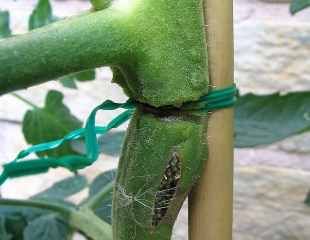
Whether you are growing tomatoes under glass or outdoors, the plants will continue to need a lot of attention. The essentials step with tomatoes, to get the flavour and texture right, is to feed and water regularly. By July, the tomato plants will grow vigorously and it's important to divert the plant's energy into fruits, not foliage.
Tomatoes are a vigorous plant, and you need to keep them in check. Nip out all side shoots, and thin down, which means cut off leaves to add light for when the flowers turn to fruit and to restrict growth. Once the plant has set 3/4 flower trusses, stop off the growing point and keep pinching it out to stop the plant growing.
As the plant grows, it will need plenty of support and tie it in using soft ties. Be careful not to tie too tightly as the image on the left shows. The tie may be loose when first placed on the plant, but as the stem grows, it can become tight, which will damage the stem and wound the plant.
For more about growing tomatoes follow the link, which gives detailed advice about watering, feeding, nipping the side shoots and other tips for growing tomatoes successfully, or buy my book! "Success with Tomatoes" by the Sunday Gardener.
Pinching out the side shoots is important because tomatoes are vigorous. If the side shoots removed, the plant will throw out more and more branches, growing thicker. What you want is fewer leaves and more flowers.
